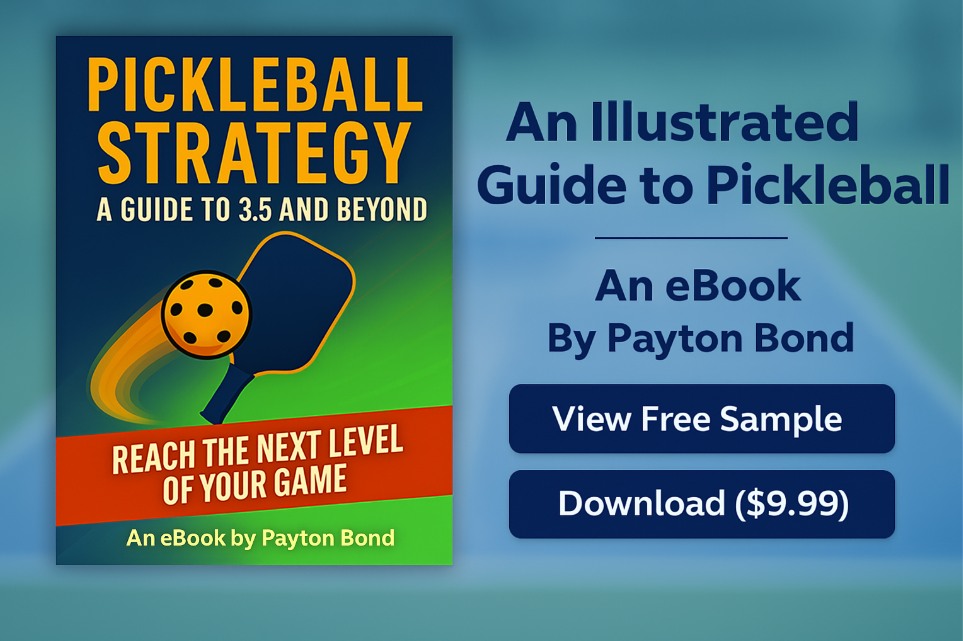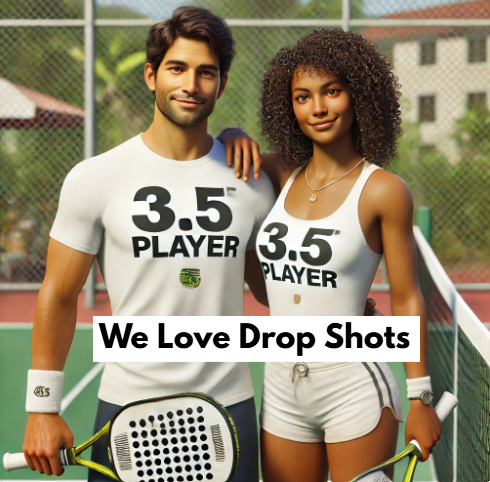
The pickleball third shot drop is your best third-shot option in most situations.
For players aiming to advance to the 3.5+ skill level, mastering this shot is non-negotiable. Consistency and precision in executing the third shot drop can turn the tables against even the toughest opponents.
Pro Tip: Think of the third shot drop as the great equalizer—it’s not about brute force, but finesse. And let’s face it, finesse feels a lot cooler when you pull it off.
Why the Third Shot Matters
The third shot in pickleball is the first shot that isn’t constrained by placement rules. The Serve has to be hit a certain way and land in the service court. On the return of serve, only one player can play the shot after they let it bounce. The third shot starts the action. After the ball bounces, either player can play the shot. This shot dictates how the rest of the point will play out and it gives the offense an opportunity to attack and set the tone.
A well-executed third shot is your ticket out of the transition zone and into an advantageous position at the net. It’s your chance to even the odds against opponents who already dominate the kitchen. Without consistent control, sharp execution, and strategic decision-making, you’ll struggle to beat stronger players.
What is the Pickleball Third Shot Drop?
The illustration below shows a third shot drop hit to the middle of the court between the 2 defenders.
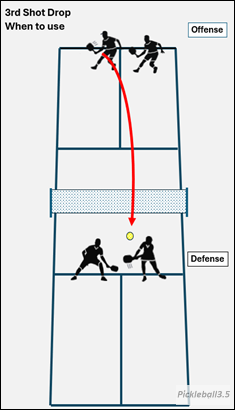
The third shot drop is a soft, controlled stroke designed to barely clear the net and land in your opponents’ kitchen zone.
A good drop shot forces your opponents to respond with a dink or an upward swing motion, robbing them of the chance to smash or volley aggressively.
Key Characteristics of the Third Shot Drop
- It just clears the net: The perfect drop shot gently lands in your opponent’s kitchen area, avoiding the dreaded “pop-up” territory.
- It bounces low: A well hit drop shot bounces below net height, making it difficult for opponents to launch a powerful drive. If it bounces too high, however, you’re basically handing them an invitation to attack.
Pro Tip: Keep it low and slow—your goal is to tempt mistakes, not provide highlight-reel opportunities for your opponents.
- It forces mistakes: When the ball bounces low, your opponent’s options shrink. If they attempt an aggressive shot, they’re more likely to hit it into the net, pop it up, or drive it out of bounds—all outcomes you’ll happily accept.
- It sets up your transition: A good third shot drop buys you the time and space to move up to the kitchen line—pickleball’s promised land, where points are often won.
Why It’s So Effective
The third shot drop slows the game down and neutralizes opponents already camped at the kitchen line. Instead of feeding their offense, you’re forcing them into defensive mode and taking control of the rally.
Pickleball Wisdom: The third shot drop may not make you the flashiest player on the court, but it’ll make you the one no one wants to face.
Why Use the Third Shot Drop?
Strong opponents are already at the kitchen line after the serve is returned, giving them the upper hand. The third shot drop slows the game and allows you to transition forward, leveling the playing field. This shot is the only reliable way to advance to the kitchen line while slowing down the point. If you are always attacking with drives, you may cause errors or popups but good players will counter your drives more easily than if you hit a good third shot drop.
Best time to use the Drop Shot
It’s most always a good idea to use the third shot drop. Counterintuitively, the best time to use this shot is often when your opponent hits a deep, lofted return.
Driving the ball on a deep return often gives your opponents an easy volley or block, especially if they are already at the kitchen line. Drives from deep on the court slow down as they travel, making them easier to defend.
A drop shot from deep that lands in the kitchen, disarms your opponent and allows you to advance.
Driving the Ball on a Short Return of Serve
While the third shot drop is your go-to shot, there are exceptions. If your opponent’s return of serve is short, your best play is usually to drive the ball back at the player who returned the serve. Your opponent hasn’t gained the kitchen line before you hit your shot, and a well-placed drive puts pressure them and allows you to advance.
Even a Bad Third Shot Drop Can Be Effective
Even bad drop shots can challenge opponents—sometimes, all you need is to make life just a little harder for them.
Why Even Mediocre Drop Shots Can Work
- Backhand Pressure:
Drop shots aimed at the backhand can be a nightmare for opponents. Defending against a low, soft shot with a backhand volley isn’t exactly their dream scenario—mishits are practically begging to happen.
- Slower Pace:
Unlike a drive, a slower drop shot forces your opponent to swing more to generate power. And let’s be honest, the more they swing, the more chances they have to mess it up. - Precision Under Pressure:
Drives can be blocked or volleyed quickly because of their speed, but a slower drop shot demands finesse. Your opponent needs to return it with precision, especially if it’s aimed at their backhand.
Pro Tip: Even if your drop shot isn’t perfect, its slower pace can disrupt your opponents’ rhythm and force them into unforced errors. Sometimes, less speed equals more trouble.
Court Positioning for the Third Shot Drop
The illustration below shows the third shot drop hit to the middle at the backhand of one of your opponents.
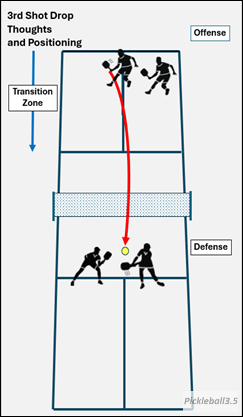
To execute an effective pickleball third shot drop, positioning is critical. It’s not just about hitting the ball—it’s about planning your approach.
Think Ahead
Before the point even begins, decide that you’re going to hit a drop shot and think about where you want to place it. This proactive approach ensures you’re ready to execute with precision.
Exception Alert: If your opponent’s return of serve is short, scrap the drop shot plan and use a drive shot—it’s like spotting an open goal in soccer; you don’t pass up the opportunity. A drive shot on a short return of serve keeps your opponents back if they haven’t reached the kitchen.
From Baseline to Kitchen: The Drop Shot’s Mission
The third shot drop is your ticket to move from the baseline to the kitchen line. This journey takes you through the transition zone—that awkward middle ground where pickleball dreams are made or broken.
Pickleball Wisdom: The baseline may be where points begin, but the kitchen line is where they’re won. The drop shot bridges the gap, leveling the playing field against opponents already parked at the line like it’s prime real estate.
By mastering the third shot drop, you’ll not only make the transition but also keep your opponents guessing—and that’s when the fun really begins.
Targeting the Backhand
Targeting the backhand is always the most effective strategy.
- Hitting to the Middle:
- If you are new to the drop shot, aim for the middle of the court to avoid hitting out of bounds.
- Look for the opponent with their backhand in the middle and target that side. If both forehands are in the middle, that’s fine—hit to the middle anyway to force a decision on who will take the shot.
- Opponent Positioning:
- If your opponents have not stacked and both backhands are in the middle, this is an even better opportunity. A well-placed drop shot forces a backhand response.
Once you’ve mastered the drop shot, you can start targeting the sidelines for even more precision and advantage. This strategy is covered in a post on targeting your third shot drops.
Advancing to the Kitchen Line
The illustration below shows a good third shot drop hit to the backhand side of the defender and the offensive players advancing through the transition zone to the kitchen line.
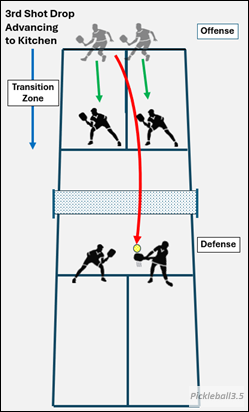
The ultimate goal of the third shot drop is to advance to the kitchen line, transitioning from defense to offense. Think of it as your golden ticket to take control of the rally—if you play it right.
Key Considerations for the Third Shot Drop
Recognizing Good Drops
- A perfect third shot drop barely clears the net and lands softly in the kitchen, making it a nightmare for your opponents to attack.
- If your drop shot forces your opponent into an awkward upward swing or a dink return, move forward quickly with your partner. This is your chance to claim the kitchen line and set up for victory.
Staying Back on Bad Drops
- Not every drop shot is a masterpiece. If your drop is too high or too fast, your opponents will happily volley aggressively—or worse, smash it right back at you.
- In these cases, resist the urge to charge forward like a hero. Instead, hang back, defend, and prepare for another drop shot—the “5th shot drop.”
Pickleball Wisdom: Charging in on a bad drop is like running into a burning building without a plan—you’re just asking for trouble.
By recognizing the difference between a good drop and a bad one, you’ll know when to advance and when to regroup. With practice, you’ll master the art of transitioning to the kitchen line and turning defense into offense—one drop at a time.
Looking for Mistakes and End the Point
When advancing to the kitchen line:
- If your opponent lofts or pops the ball up, put it away if it’s within reach above the net.
- Good players will often concede your advance after a strong drop shot and respond with a dink. They know if they try to make an aggressive shot off your drop shot, they will likely make a mistake. They transition the point into a dinking rally. This is what you want.
Common Mistakes to Avoid
- Lofted Drop Shots: High, slow drop shots invite smashes from your opponent. Of course, you don’t want to do this, but all your drop shots won’t be great.
- Advancing Too Early: Only move forward aggressively on a good drop shot.
Pickleball Third Shot Drop Summary
To advance to the 3.5 level in pickleball, mastering the third shot drop isn’t just recommended—it’s required. Think of it as your golden key to unlocking higher-level play.
Why the Third Shot Drop Is a Game-Changer
This shot does it all:
- Neutralizes Strong Opponents: A well-placed drop shot takes the wind out of the sails of opponents parked at the kitchen line, turning their advantage into your opportunity.
- Helps You Transition Forward: It’s your secret weapon to move from the baseline to the kitchen, where the real action happens.
- Forces Errors: By keeping the ball low and soft, you leave your opponents scrambling, popping it up, or hitting into the net—all mistakes you’ll happily capitalize on.
Your Most Valuable Third Shot Option
The third shot drop isn’t flashy, but it’s the cornerstone of advanced play. While it may take time (and a few frustrating mishits) to master, don’t give up. Every time you perfect this shot, you’re taking a step closer to dominating the court.
Pickleball Truth: The third shot drop may not win you style points, but it will win you games—and that’s what matters.
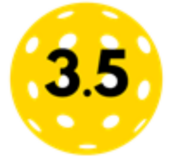
👤 Follow Payton Bond
Stay connected to Pickleball35.com and check out more strategy posts on Facebook!
Keep Learning
- Watch the videos 🎥 below on the Third Shot Drop.
- Read the post on how to execute Drop Shots.
- Read the next post in the Third Shot series: Advanced Pickleball Drop Shots – The 5th and 7th Shot Explained.
